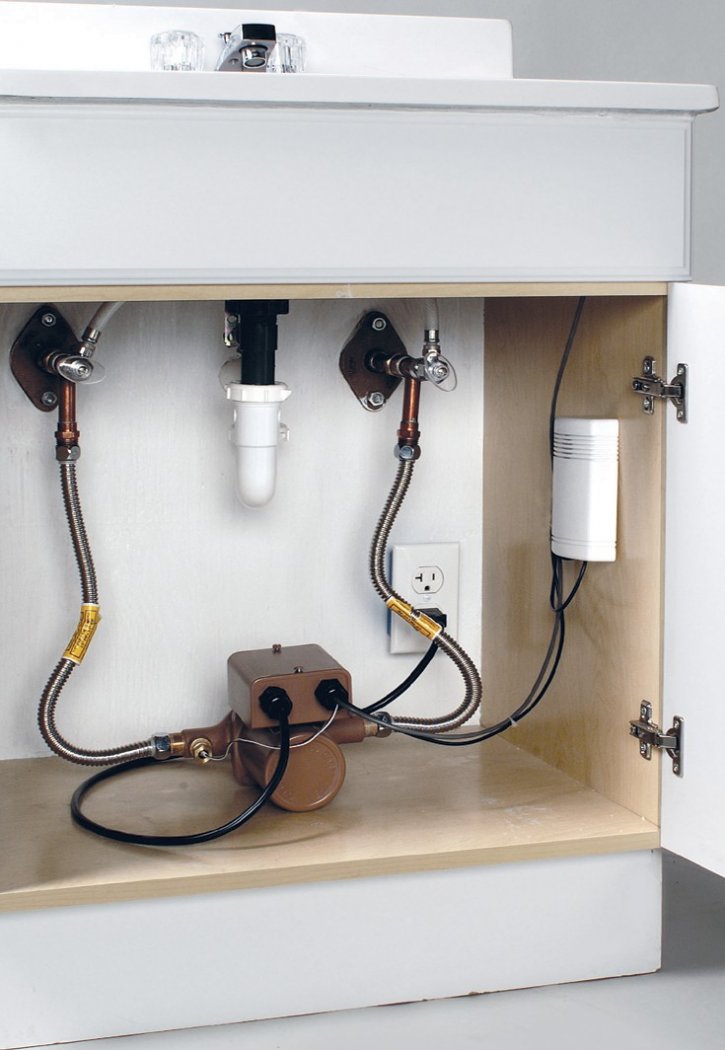Blog Post
Waiting for Hot Water

Over the past several weeks, I've written about water conservation as a strategy for saving energy and examined a number of water heating options. This week, we'll look at the issue of water waste while waiting for hot water and what to do about it.
Here's the problem: Most of us waste a lot of water waiting for hot water to reach a sink or shower. In a large house, it's not unusual for 50 feet of piping--or more--to extend from the water heater to the most distant fixtures. And with 50 feet of pipe, it can take a long time for hot water to reach the tap; while waiting all the water goes down the drain.
How long you have to wait for hot water depends on three factors: the distance from the water heater, the diameter of the piping, and the flow rate. The effect of distance is pretty obvious: the further hot water has to flow, the longer it will take to get there. With a new house, you can keep plumbing runs short by locating bathrooms and the kitchen near each other.
The effects of pipe diameter and flow rate aren't quite so intuitive. The smaller the diameter, the faster hot water will reach the tap. That's because smaller-diameter pipe holds less water. Fifty feet of 1/2"-diameter pipe holds 0.8 gallons, while the same length of 3/4" pipe holds 1.4 gallons and 1" pipe holds 2.3 gallons. When you're waiting for hot water, all of the cooled-off water sitting in the pipe has to flow out before hot water from the water heater reaches the tap.
The flow-rate of a faucet or showerhead affects the wait for hot water because it governs how quickly the cooled water sitting in the pipes will be emptied out. If you have a water-conserving bathroom faucet that delivers only a half-gallon per minute (gpm) and most of the piping in the house has 3/4" piping, a 50-foot run from the water heater requires almost three minutes to get hot water to your sink.
The irony is that even as the flow rates of faucets and showerheads has dropped, plumbing codes are increasingly mandating larger-diameter piping--so the wait times for hot water have increased--a fact that's exacerbated by the larger houses we're building.
SUPPORT INDEPENDENT SUSTAINABILITY REPORTING
BuildingGreen relies on our premium members, not on advertisers. Help make our work possible.
See membership options »In addition to the long wait for hot water, all of the cooled-off water sitting in the pipe goes down the drain. Nationally, there's a huge amount of water wasted in this way.
Additional water (and energy) waste will occur if you tend to turn on the shower and then go do something else as you wait for hot water. This all-too-common practice can be extremely wasteful, especially if you leave the bathroom and get distracted after turning on the water.
So what can we do about this problem? The most common solution is a bad one: installing a continuous-circulation pump. These circulators, standard in most hotels, keep hot water flowing through the plumbing loop in a house all the time so that hot water is always available with almost no delay. The problem with this approach is that you waste energy. Your entire hot-water piping system acts like a radiator that operates 24/7. Insulation on the pipes helps, but there are still significant losses.
A much better solution is an "on-demand circulator." With this system, a user in a remote bathroom or kitchen pushes a button to activate a small pump, usually under the sink. This pump pulls hot water from the water heater, and sends the cooled-off water that's been sitting in the pipes back to the water heater, either through a separate piping return that has been installed (most common in new construction), or via the cold-water line (more common in retrofit applications). As soon as hot water reaches the tap, a temperature-controlled switch turns off the pump. The system is also available with an occupancy sensor--to automatically turn on the circulator pump when someone enters the bathroom, though this will lead to some waste since the circulator will operate whether or not hot water will be needed.
Several manufacturers offer the same basic on-demand recirculator, called the D'Mand system, which was developed by ACT Metlund. ACT Metlund sells the system online and also licenses the technology to pump manufacturer Taco and Swedish plumbing and heating system manufacturer Uponor, which was previously known as Wirsbo.
If you don't want to go to the expense of buying an installing the D'Mand system (the unit costs over $300, plus installation), you can at least deal with the excessive waste that occurs if you often leave the shower on longer than needed while waiting for hot water--by installing a specialized showerhead valve. With the Lady Bug showerhead adapter made by Shower Start, LLC, or an integral showerhead that includes this adapter, you turn on the shower and when hot water reaches the valve, flow is reduced to a trickle. After stepping in the shower, you turn a knob or pull an attached cord to resume full flow.
In new construction, reducing waste while waiting for hot water can also be accomplished with a "structured" or "home run" plumbing system, in which separate lengths of cross-linked polyethylene (PEX) tubing extend from a manifold at the water heater to each water-using fixture or appliance. With this increasingly common approach, waste is reduced by matching the PEX tubing diameter to the flow rate of the fixture--so that small-diameter tubing that holds relatively little water is used with low-flow fixtures.
Published June 22, 2009 Permalink Citation
(2009, June 22). Waiting for Hot Water. Retrieved from https://www.buildinggreen.com/blog/waiting-hot-water



Add new comment
To post a comment, you need to register for a BuildingGreen Basic membership (free) or login to your existing profile.